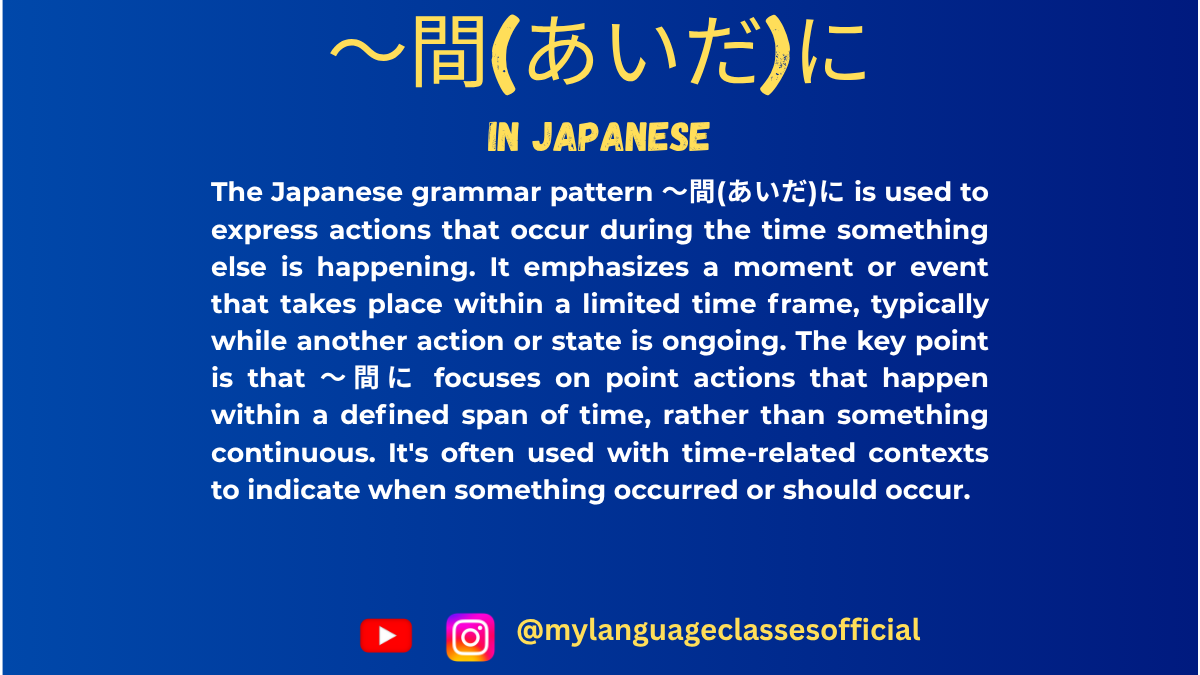Your cart is currently empty!
Using 〜間(あいだ)に in Japanese

How to Use 〜間(あいだ)に in Japanese
The phrase “〜間(あいだ)に” is an important grammatical structure in Japanese that signifies an action that occurs within a specific time frame or during another ongoing action. In this blog post, we will explore all the possible usages of “〜間に,” provide example sentences, practice exercises, and conclude with essential points to remember.
Situations Where 〜間(あいだ)に is Used
- An event occurring within a specified time frame:
- This indicates that something happens while another action or state continues for a limited duration.
- An event occurring before another event finishes:
- The action expressed in “〜間に” must be completed within the time frame of the main action.
- Unexpected occurrences:
- Sometimes, something unplanned or sudden happens within the given time span.
- Used with verbs in their progressive (〜ている) or non-progressive forms:
- The verb preceding “間に” can be in its progressive (e.g., 勉強している間に) or simple form (e.g., 勉強する間に), but the nuance changes slightly.
Example Sentences with Romaji and English Translation
- 母は買い物をしている間に、私は家の掃除をしました。
Haha wa kaimono o shite iru aida ni, watashi wa ie no souji o shimashita.
(While my mother was shopping, I cleaned the house.) - 私がシャワーを洗っている間に、妻は昼ごはを作っていました。
Watashi ga shawaa o aratte iru aida ni, tsuma wa hirugohan o tsukutte imashita.
(While I was taking a shower, my wife was making lunch.) - 休憩している間に、メールを確認した。
Kyuukei shite iru aida ni, meeru o kakunin shita.
(While I was taking a break, I checked my email.) - 先生がお話している間に、学生たちはメモをとった。
Sensei ga ohanashi shite iru aida ni, gakusei-tachi wa memo o totta.
(While the teacher was talking, the students took notes.)
Fill in the Blanks Exercise
- 私がテレビを見ている____, 妹は引き出しを整理していた。
- 父が電話をしている____, 子供たちは遊んでいた。
Answers:
- 間に
- 間に
Things to Keep in Mind
- The phrase “〜間に” always denotes an action that happens within the specified period.
- The action occurring within “〜間に” must be completed before the main event ends.
- It is different from “〜間” without “に” which focuses on continuity rather than completion.
- “〜間に” is often used for brief actions rather than prolonged ones.
- Some verbs are naturally suited for this structure, like 見る (miru, to see), 読む (yomu, to read), etc.
Conclusion
Mastering “〜間に” is crucial for understanding Japanese time expressions. This structure allows speakers to describe events occurring within a specific time frame accurately. By practicing with examples and exercises, learners can improve their fluency and comprehension. Keep practicing, and soon, using “〜間に” will become second nature!
If you enjoyed this lesson, be sure to check out more posts like this on my blog at My Language Classes. Don’t forget to subscribe my YouTube channel and follow me on Instagram for the latest language learning tips and lessons. Leave a comment below to share your thoughts, or ask any questions you have about nouns.
Happy learning! 😊
📚 Continue Learning Japanese
Vikas Kumar is a dedicated language educator, content creator, and digital entrepreneur, best known as the co-founder of My Language Classes and The Curious Mind. With a strong focus on helping learners achieve fluency in English, Spanish, and Japanese, he has guided audiences worldwide through a diverse range of resources, including in-depth blog articles, engaging YouTube tutorials, and comprehensive Books.
Through My Language Classes, Vikas has built a thriving multilingual learning platform that serves students, travelers, and professionals eager to master communication skills for personal, academic, and professional success. His expertise extends to exam preparation for internationally recognized certifications such as JLPT, DELE, IELTS, and TOEFL, enabling learners to achieve tangible, career-enhancing results.
As the founder of The Curious Mind, he also explores broader areas of knowledge, including self-help, motivation, modern learning strategies, and thought-provoking insights on life and personal growth. His work blends practical teaching methods with a deep understanding of learner psychology, making complex concepts accessible and engaging.
Driven by a mission to make high-quality education accessible to all, Vikas continues to expand his reach across multiple platforms, including YouTube, blogs, eBooks, and social media communities, inspiring thousands to learn, grow, and embrace lifelong learning.


Leave a Reply